[Click on BLUE links for sources and more information]
If economists could manage to get themselves thought of as humble, competent people on a level with dentists, that would be splendid.
John Maynard Keynes
Keynes, the famous economist, had too exalted a view of dentists, engineers, technicians. Dentists are as greedy and vain as the rest of us. It was a dentist who invented the process to produce cotton candy for the masses thereby assuring a steady stream of customers.
For 300 years, the confection stayed in fashion — but only among elite circles. Ornately-spun Easter eggs and “webs of gold and silver” were rare delicacies for high-society Europeans. Italians were particularly skilled at sugar spinning; as one historian describes, Venetians “moulded it into a fantastic tableaux of animals, mythic figures, buildings, birds, and pastoral scenes.” When Henri III of France visited Venice in the late 1500s, he was treated to a fanciful banquet at which 1,286 items — including the tablecloth — were spun of sugar. For the average citizen though, the treat remained widely inaccessible …
… Morrison’s biggest breakthrough came in 1897, when he paired with John C. Wharton, an old pal and fellow confectioner. Together, the two designed and co-patented what they called the “electric candy machine.” Utilizing centrifugal force, the device rapidly spun and melted sugar through through small holes until it was fluffy and nearly 70% air. They called the new treat “fairy floss,” formed the “Electric Candy Company,” and spent several years perfecting the process before debuting it to the public.
At the 1904 Louisiana Purchase Exposition (more popularly known as the 1904 World’s Fair), the duo introduced their product, selling it in small wooden boxes for twenty-five cents each (about $6 today) — nearly half the admission price to the fair. Despite its high price, the candy floss was a smash success. Over 184 days, Morrison and Wharton sold 68,655 boxes, grossing $17,163.75 ($438,344 in 2014 dollars). [LINK]
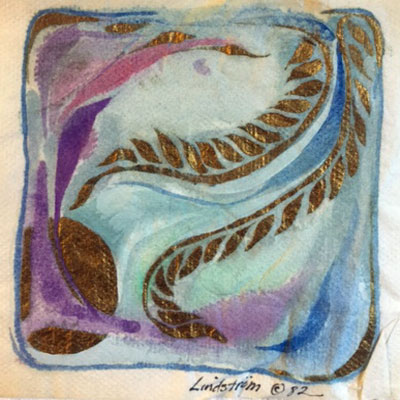
Sea Gull Cellar Bar Napkin Art, Sandra Lindstrom artist
It is not fashionable today to be the “humble, competent” folks envisioned by Keynes. The turnaround may have started when one dentist was involved in the mysterious murder of another dentist in San Francisco in 1879. The murder occurred because of a patent dispute over dentures. Technology has graduated from the days of George Washington’s wooden teeth but not human nature.
I don’t mean to single out the poor dentists. There is something peculiarly American about secularizing and monetizing the most holy of Christian religious holidays that transcends dentistry. For Candy Companies, Easter Is the Sweetest Day of the Year.
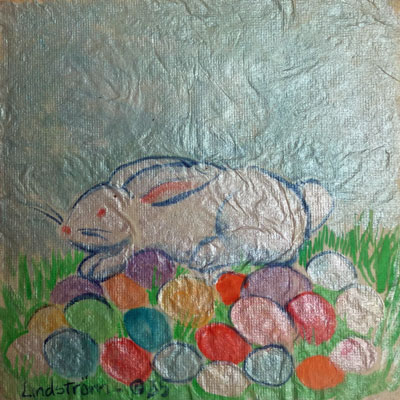
Sea Gull Cellar Bar Napkin Art, Sandra Lindstrom artist
“Hedwig didn’t return until the end of the Easter holidays. Percy’s letter was enclosed in a package of Easter eggs that Mrs. Weasley had sent. Both Harry’s and Ron’s were the size of dragon eggs, and full of home-made toffee. Hermione’s, however, was smaller than a chicken’s egg. Her face fell when she saw it.
“Your mum doesn’t read Witch’s Weekly, by any chance, does she, Ron?” she asked quietly.
“Yeah,” said Ron, whose mouth was full of toffee. “Gets it for the recipes.”
Hermione looked sadly at her tiny egg.”
J.K. Rowling, Harry Potter and the Goblet of Fire
But, why spoil a good time? Why go so far as to describe What Actually Happens To Your Body When You Eat An Easter Egg? [HINT: If you click the link and read the article, Easter will never be the same.] Let’s just celebrate Easter in good faith.
For those unsuspecting parents who think dark chocolate is a healthier treat, consider this. Dark chocolate contains a lot more caffeine. Not only does caffeine send children stark, raving mad, it can also lead to rapid heartbeat, anxiety, depression, restlessness, sleep problems, tremors, nausea and vomiting, according to the article cited above.
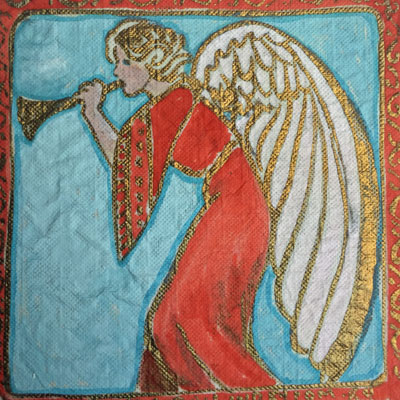
Sea Gull Cellar Bar Napkin Art, Sandra Lindstrom artist
Christians appropriated the Easter story and many of their other religious ideas from the pagans who preceded them. See, for example, The Pagan Roots of Easter or The Origins of Easter: From Pagan Roots to Bunnies to Chocolate Eggs.
I have my personal story of how Easter came about inspired by my limited knowledge of Mexico and mezcal. [See Jesus Mezcal and the Easter Bunny]. I thought it might be a little too crazy at the time but I’ve come to see that my story is not uncharacteristic of many Easter stories and traditions. It doesn’t take a stretch of the imagination to get the connection between the Easter bunny and fertility, spring, and resurrection. But, consider the brown hare. [A hare is a fast-running, long-eared mammal that resembles a large rabbit.] According to Science Daily, the brown hare can conceive a second batch before the first batch is delivered. No kidding. It’s called superconception and it improves the hare’s reproductive success. No wonder the pro-life crowd chooses the Easter Bunny to celebrate their most sacred day.
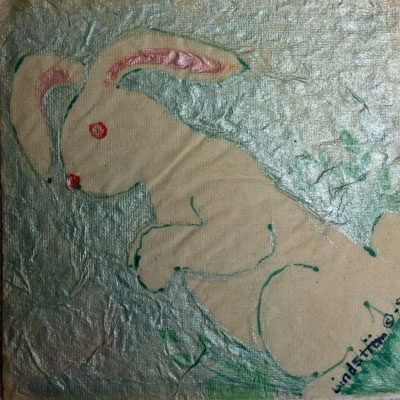
Sea Gull Cellar Bar Napkin Art, Sandra Lindstrom artist
In 1984, Ronald Reagan had his Secret Service agents dress up as the Easter Bunny for the annual Easter Egg Roll. The Easter Egg Roll has been a White House tradition since 1878 as a workaround of the Turf Protection Law. In 2016 an Easter Bunny got into a bizarre brawl at a New Jersey shopping center. Let’s hope nothing similar occurs at this years White House Easter Egg Roll.
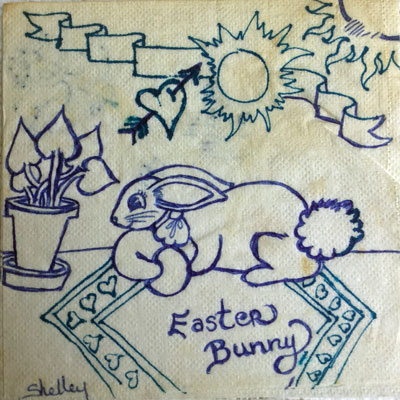
Sea Gull Cellar Bar Napkin Art, Shelley artist
Throughout history there have been many odd Easter traditions. In Corfu on Easter Saturday the locals throw clay pots out their windows, smashing them on the ground to cast out evil. In another Greek town, Vrontados on the island of Chios, there is a rocket war between churches around midnight as Easter Sunday begins. In Norway Easter is a special time to read a crime novel. In Germany, dancing is not allowed on Good Friday.
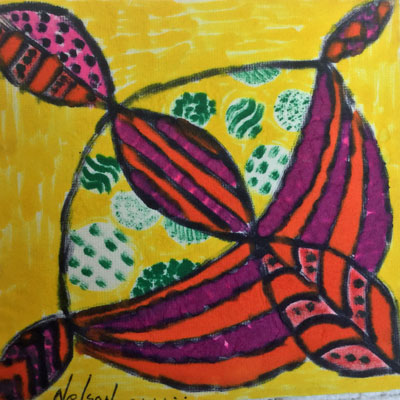
Sea Gull Cellar Bar Napkin Art, Nelson artist
“Christmas and Easter can be subjects for poetry, but Good Friday, like Auschwitz, cannot. The reality is so horrible it is not surprising that people should have found it a stumbling block to faith.”
W.H. Auden
In the Czech Republic, women are whipped with willow branches to ensure vitality and fertility. In Hungary on Watering Monday of the Holy week (Dyngus Day in Poland) men throw buckets of cold water over women to assure they don’t wither like flowers.
In France, Belgium, and the Netherlands children are told that the church bells come out of their steeples and fly to Rome. When the bells return they bring chocolate and colored eggs. In Louisiana some folks knock their eggs together. Whoever’s egg breaks first loses. In Bermuda they fly Easter kites to commemorate Jesus’s ascension to heaven. In Italy, a mechanical dove goes on fire and sets light to a big cart full of fireworks. In the city of Florence this tradition goes back to the Crusades. A fire is lit using flints made out of stone from the Holy Sepulchre in Jerusalem. This is used to light a rocket strapped to a fake dove, which then shoots along a wire and lands in a 30 foot high cart full of fireworks.
In Jamaica people eat hot cross guns.
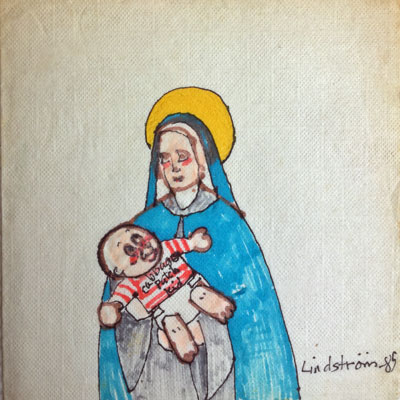
Sea Gull Cellar Bar Napkin Art, Sandra Lindstrom artist
While some people think that Christians eat ham for Easter as a form of insult towards Jews (kind of obnoxious, really), the origin of eating ham at Easter goes back much further than Christianity. Pagan cultures, having slaughtered their meat animals in the Fall, preserving them for the Winter months, now ate up the last of those preserved meats. The custom of lamb for Easter dinner comes from the Jewish Passover holiday. On that day, a sacrificial lamb was eaten, along with other symbolic foods, at the Passover Seder. The Christians adopted the lamb as a symbol of Jesus and retained the custom.
SOURCE: 10 Things You May Not Know About Easter
In spite of the many strange traditions, Easter is considered a pious celebration of the resurrection. (No Donald, that’s RESurrection.).
The themes of Easter, though considered religious by the faithful, can also appeal to nonbelievers.
“Let us be grateful to people who make us happy; they are the charming gardeners who make our souls blossom.”
Marcel Proust
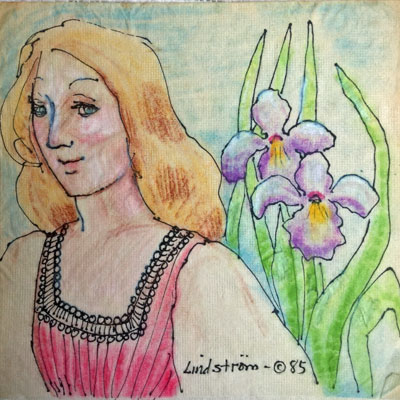
Sea Gull Cellar Bar Napkin Art, Sandra Lindstrom artist
For Proust, the composition of his novel was, in a sense, a religious experience, a pilgrimage for lost time. The experience was regenerated with the incident of the “madeleine” dipped in his tea, causing a spiritual materialization of the town of his childhood happiness, Combray. Having taken place during the Easter season, it magnifies the theme of resurrection which he compares with memory.
“The resurrection at our awakening-after that beneficent attack of mental alienation which is sleep-must after all be similar to what occurs when we recall a name, a line, a refrain that we had forgotten. And perhaps the resurrection of the soul after death is to be conceived as a phenomenon of memory.”
Proust, The Guermantes Way
Jorges Borges dwells on similar thoughts about dreams and resurrection throughout his writings.
“It must be that I am not made to be a dead man, but these places and this discussion seem like a dream, and not a dream dreamed by me but by someone else still to be born.”
Borges, Dreamtigers
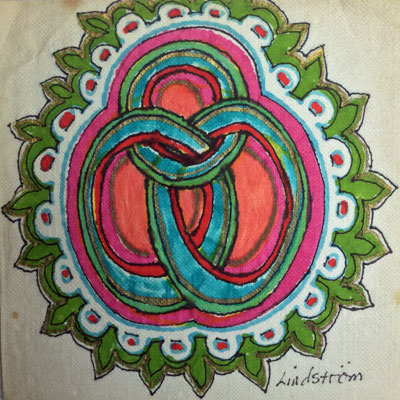
Sea Gull Cellar Bar Napkin Art, Sandra Lindstrom artist
Albert Camus also uses the resurrection theme both positively and negatively throughout his writings.
“In the depths of winter I finally learned that there was in me an invincible summer.”
Camus, The Stranger
And, indeed, as he listened to the cries of joy rising from the town, Rieux remembered that such joy is always imperiled. He knew what those jubilant crowds did not know but could have learned from books: that the plague bacillus never dies or disappears for good; that it can lie dormant for years and years in furniture and linen-chests; that it bides its time in bedrooms, cellars, trunks, and bookshelves; and that perhaps the day would come when, for the bane and the enlightening of men, it would rouse up its rats again and send them forth to die in a happy city.
Camus, The Plague
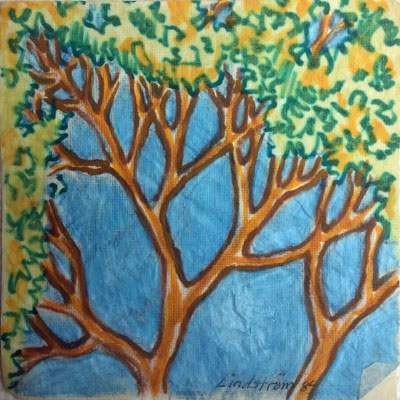
Sea Gull Cellar Bar Napkin Art, Sandra Lindstrom artist
Roberto Bolaño wrote a complex Easter poem based on the famous Arnolfini painting by Jan van Eyck.
Resurrection said the traveler at the inn,
perhaps an Arab
or a South American,
and he slept beside the fire.
The Arnolfinis crackled in the blaze:
trail crossing fields and rains,
periods of fertilization and harvest, history
is elusive
but sometimes mystery falls into our
dreams
like a bird in a little girl’s lap.
The Arnolfinis, my love,
the resurrection said the traveler,
our time has no end.
Roberto Bolaño, The Unknown University
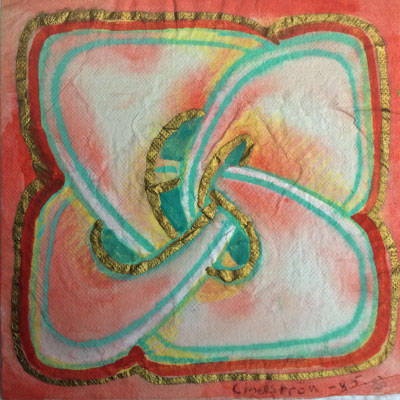
Sea Gull Cellar Bar Napkin Art, Sandra Lindstrom artist
I’ll end my Easter thoughts with this poem by A. E. Housman, one of my favorites although he thought the poem was inferior.
Easter Hymn
A.E. Housman
If in that Syrian garden, ages slain,
You sleep, and know not you are dead in vain,
Nor even in dreams behold how dark and bright
Ascends in smoke and fire by day and night
The hate you died to quench and could but fan,
Sleep well and see no morning, son of man.
But if, the grave rent and the stone rolled by,
At the right hand of majesty on high
You sit, and sitting so remember yet
Your tears, your agony and bloody sweat,
Your cross and passion and the life you gave,
Bow hither out of heaven and see and save.
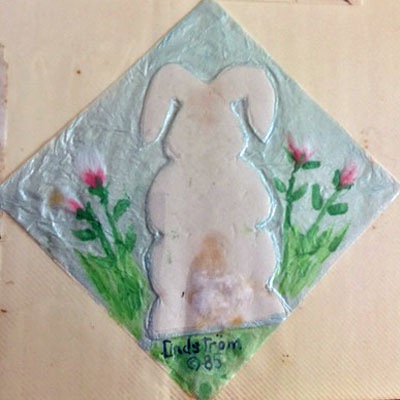
Sea Gull Cellar Bar Napkin Art, Sandra Lindstrom artist

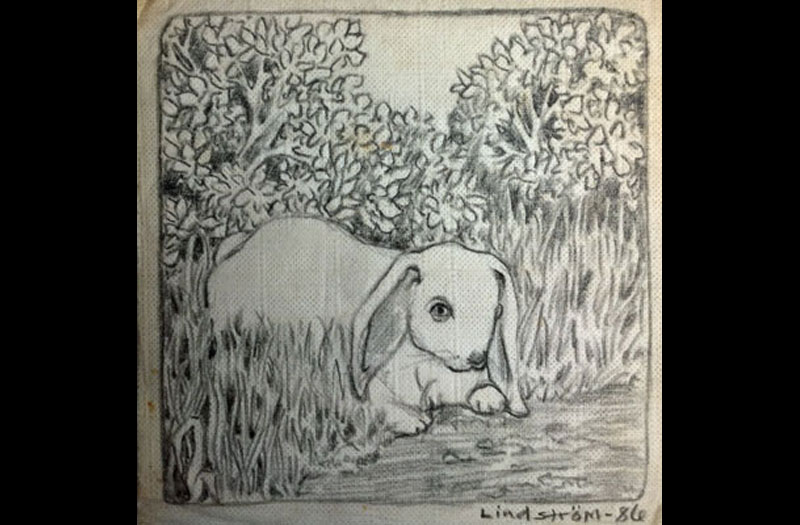
I am so glad you celebrated Sandra with her art.
Sandra is fabulous, as you know. I Remember the Easter eggs she used to decorate. And that fabulous painting of the fairies dancing under the moon in the forest, it’s one of the few I removed when I sold the restaurant. I should have removed them all.
What an interesting piece. Thanks for sharing my mother’s art and I’m laughing because ironically we own a dental practice. Happy Easter!
Are you Sandra’s daughter? I have such fond memories of her all those years ago at the Sea Gull. You must be one of the little girls in the picture with the dragon eggs. I so regret not taking all of the art I loved out of the restaurant. My intention was to leave it for the community and it never occurred to me that the business would fall apart as fast as it did. You also might be one of the girls dancing in the woods. You will find that painting (which I do have) near the bottom of this blog.https://thinkinthemorning.com/the-sea-gull-as-art/
We need dentists, I especially ! Thanks for your comment, David
Yes, I’m the little girl in the middle. Your restaurant was my favorite thing when I was little. I loved the hot chocolate and got it every time we were downstairs. I loved the classical music that played in the dining room and I remember all the napkins that my mom would draw! I am so thrilled that someone told me about your blog. How have you preserved all of the napkins? What happened to all of the artwork in the bar? Is it gone? It was really so special. I remember every one of the pieces vividly.
That’s all so good to hear. Thank you. I left almost everything in the restaurant and I don’t know what the new owner did with it. As for the napkins, I have kept some. The others are in private collections, some at the Kelley House. If I can’t acquire them, I at least try to photograph them to use in this blog.
James Maxwell has prints of his door-sized Seagull portraits, which lined the ceiling, currently for sale. Lovely Prints. The can be seen on his website.
http://www.artistjamesmaxwell.com/seagull.html
Thanks. I linked to those in a previous post
https://thinkinthemorning.com/the-sea-gull-paintings/